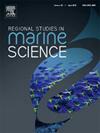孟加拉国孟加拉湾海岸沉积物地球化学、潜在有毒元素污染和生态风险的基线毒性评估
IF 2.4
4区 环境科学与生态学
Q3 ECOLOGY
引用次数: 0
摘要
近年来,孟加拉国孟加拉湾海岸的海洋生态系统受到人为活动的显著影响。然而,孟加拉国孟加拉湾沉积物剖面中潜在有毒元素(pte)的污染很少被提及。收集了一个150 cm长的沉积物岩心,从pte污染和生态风险方面评估沉积物质量。沉积物中Cr、Ni、Cu、As、Cd、Pb、Fe、Mn、Zn的pte值分别为6.05 ~ 104.2、9.31 ~ 81.8、6.57 ~ 112.9、1.98 ~ 17.0、0.48 ~ 6.49、1.85 ~ 72.5、12080 ~ 35365、90.8 ~ 810.2和11.1 ~ 109.5 mg/kg。沉积物中Cu、As、Cd和Pb的总体平均浓度显著高于标准值,表明其受到污染。考虑沉积物岩心深度(0 ~ 20、20 ~ 100、100 ~ 150),考克斯巴扎尔区潜在生态风险指数(RI)分别为299.2、199.5、151.7,吉大港区420.7、313.7、161.5,梅克纳河口区210.6、211.5、147.8,孙德尔本斯区195.4、133.6、89.1。沉积物交换分数(F1)中pte的地球化学分布顺序依次为Cd >; Pb >; Ni >; Zn >; Cu >; Mn >; As >; Fe >; Cr,表明Cd和Pb具有不利的生物毒性作用。富集因子(EF)、地质堆积指数(Igeo)、污染因子(CF)和沉积物质量指标(SQGs)结果表明,沉积物剖面受到Cu、As、Pb、Zn等元素的严重破坏。多元统计分析表明,大部分pte富集于人类活动沉积物中。本文章由计算机程序翻译,如有差异,请以英文原文为准。
A baseline toxicity assessment of sediment geochemistry, potentially toxic elements contamination, and ecological risk in sediment profiles of the Bay of Bengal coast, Bangladesh
The marine ecosystems of the Bay of Bengal Coast, Bangladesh have been significantly influenced by anthropogenic activities in recent times. However, the contamination of potentially toxic elements (PTEs) in sediment profiles in the Bay of Bengal, Bangladesh has rarely been stated. A 150-cm-long sediment core was collected to assess the quality of sediments in terms of PTEs contamination and ecological risk. The ranges of PTEs in sediments were 6.05–104.2, 9.31–81.8, 6.57–112.9, 1.98–17.0, 0.48–6.49, 1.85–72.5, 12080–35365, 90.8–810.2, and 11.1–109.5 mg/kg, respectively for Cr, Ni, Cu, As, Cd, Pb, Fe, Mn, and Zn. The overall mean concentrations of Cu, As, Cd, and Pb in sediments were remarkably higher than the standard value, indicating their contamination. Considering the depths of sediment core (0–20, 20–100, and 100–150), potential ecological risk index (RI) were observed as 299.2, 199.5, 151.7 for Cox's Bazar, 420.7, 313.7, and 161.5 for Chittagong, 210.6, 211.5, and 147.8 for Meghna Estuary, and 195.4, 133.6, and 89.1 for the Sundarbans area. The geochemical distribution of PTEs in the exchangeable fraction (F1) of sediments followed in the descending order of Cd > Pb > Ni > Zn > Cu > Mn > As > Fe > Cr, indicate that Cd and Pb had adverse biological toxicity effects. Results of enrichment factor (EF), index of geoaccumulation (Igeo), contamination factor (CF), and sediment quality guidelines (SQGs) suggested that the sediment profiles were considerably degraded by some elements i.e., Cu, As, Pb, and Zn. The multivariate statistical technique indicated that most of the analyzed PTEs were enriched in sediments from anthropogenic activities.
求助全文
通过发布文献求助,成功后即可免费获取论文全文。
去求助
来源期刊

Regional Studies in Marine Science
Agricultural and Biological Sciences-Ecology, Evolution, Behavior and Systematics
CiteScore
3.90
自引率
4.80%
发文量
336
审稿时长
69 days
期刊介绍:
REGIONAL STUDIES IN MARINE SCIENCE will publish scientifically sound papers on regional aspects of maritime and marine resources in estuaries, coastal zones, continental shelf, the seas and oceans.
 求助内容:
求助内容: 应助结果提醒方式:
应助结果提醒方式:


